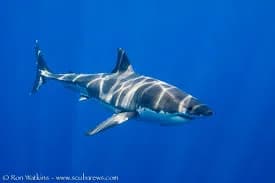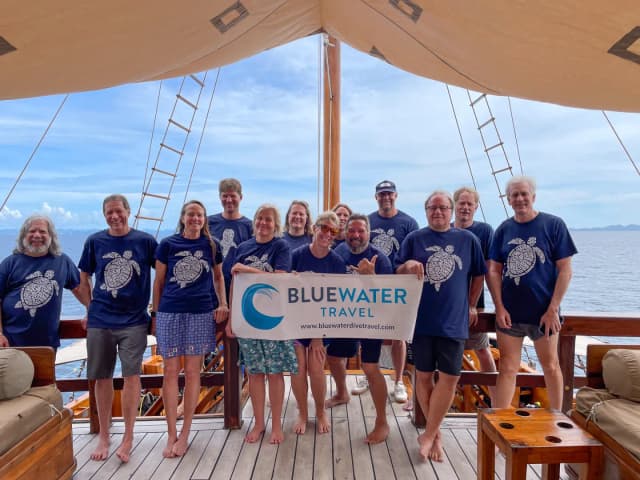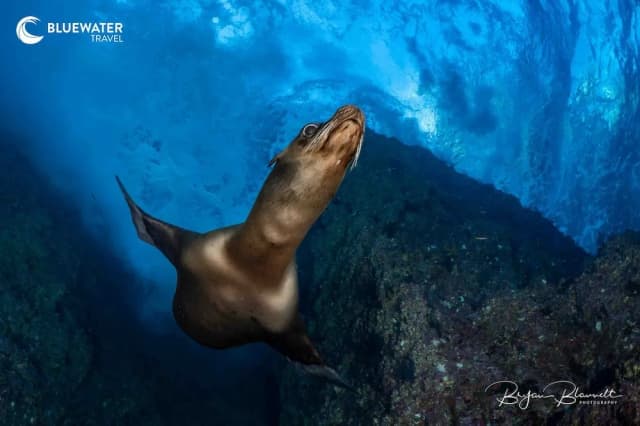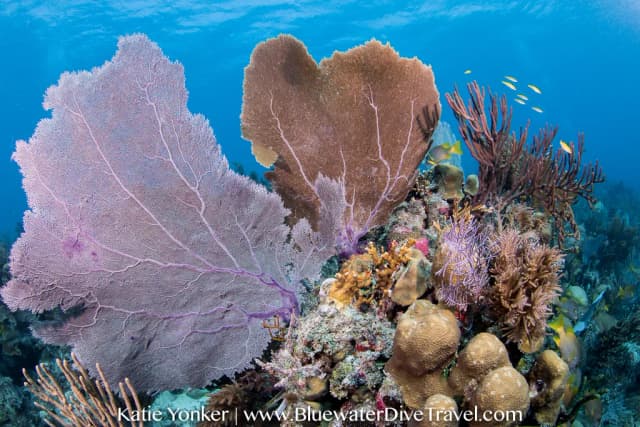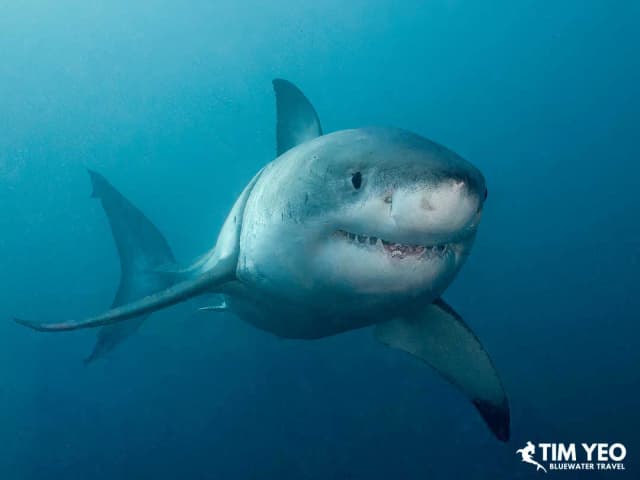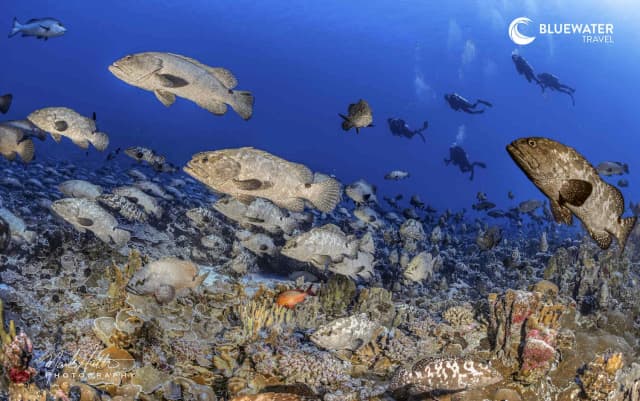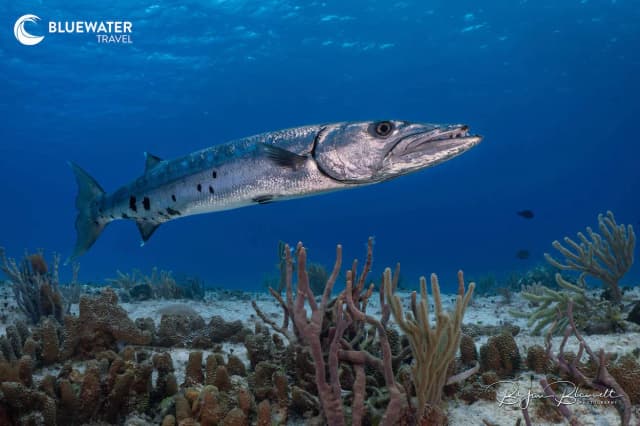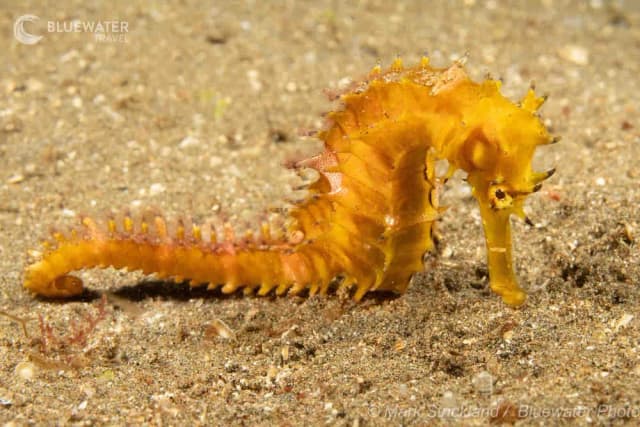Bluewater Travel Guadalupe 2016 Trip Report, And
A Personal Account Of A Terrifying Great White
Encounter
By Katie Yonker
This September marked the 2nd annual Bluewater Travel Guadalupe group trip, and I can confidently say it was an experience like none other.
Known for its deep blue water, great visibility, and easy access from the western US, Guadalupe Island is one of the best locations in the world to see sharks up close, particularly the great white sharks. This September I led a group of excited divers, most of whom had never seen a great white, for an experience that none of us could have anticipated.
We met in San Diego in the evening and boarded the bus for a 2-hour ride south to Ensenada, where the Nautilus Explorer awaited our arrival. Other boats that visit this site include the Solmar V and the Vortex liveaboard. I was excited because this trip had always been on my scuba diving bucket list.
We were welcomed aboard with cocktails, shown to our cabins, and introduced to the crew, whom we would entrust with our lives for the next several days. After a briefing of the boat and a practice safety drill, and testing our underwater photography equipment, we retired to bed and began the ~20 hour ride to Guadalupe.
Guadalupe Island at sunset
The following day was spent getting to know each other, setting up camera equipment for shark photography, playing cards, and eagerly discussing the days to come. We arrived to Guadalupe around 9:00pm and many people watched as the cages were loaded into the water.
Nautilus Explorer is equipped with two 35-foot submersible cages that each hold three people, and two surface cages that each accommodate four people. Starting this year, Nautilus Explorer obtained permits to wrangle at the surface, a practice many other boats have been utilizing for years. This involves tossing a piece of tuna in the water and pulling it in as the sharks approach, which provides an opportunity for dramatic mouth-open photographs of the sharks. The submersible cages descend with one bag of fish chum which entices sharks with its scent, but the chum remains in the bag and the sharks are never fed from the bag. The dive schedule consists of rotating 45-minute time slots in the submersible cages, and time in the surface cages is virtually unlimited.
Day one of diving started off with a bang! Instead of seeing two to three sharks at a time like the previous year, we often saw three or more, and towards the end of the day we saw up to seven at one time. Another difference from last year is that the big females had arrived this season, which are usually quite a bit larger than their male counterparts. As the day went on and the number of sharks increased, so too did their comfort level in approaching the cages. Even though the sharks came right up to the cages and in some cases mouthed the bars, you still got a sense that these are curious animals who are only interested in the smell of dead fish, not eating you for dinner.

The morning of day two was a little quieter than the previous morning, but once again, by the afternoon the shark action picked up. For the 3:30pm submersible dive I was joined by David, Katie B., and divemaster Yann for an experience none of us will ever forget.
The dive started off like any other. We descended down to about 35 feet and within minutes there were a few sharks circling the cages. There were several people in the surface cages looking on, and no wrangling was happening at the time. Katie B. joined Yann on the upper level of the cage (known as the balcony) and David and I remained below. Less than halfway through the dive a female shark approximately 13 - 15 feet long approached Yann and he pushed her away from the cage. A few seconds later, the shark bit the air hose that supplies air from the surface to the divers in the cage, creating an explosion of air bubbles. Yann noticed an immediate loss of air flowing to his regulator, so he descended a few feet down to turn on the one-way valve from the surface supply hose so that the hookah system would not lose pressure. This was done so quickly that neither David, Katie B., nor I experienced a loss of air. While Yann was turning on the valve, the shark swam vertically down into the balcony of the cage, made a sharp turn, and swam right through the bars of the cage. She thrashed around for several seconds and in the process got further lodged into the bars of the cage.
After about 30 seconds, Katie B. was able to descend down the ladder to the lower part of the cage to join David and me. We stood, gripping the cage in an attempt to stay upright while the cage circled back and forth and at one point was at a 45-degree angle due to the sharks thrashing. Yanns regulator had been knocked out of his mouth by the shark, so he retreated to the surface to catch a breath of air and to tell the crew to bring up the cage. I turned on my GoPro just in time to capture the largest shark we had seen, Air Demon AKA Big Mama, swimming vertically within a few feet of our cage only seconds after Yann had exited the cage and ascended to the surface. Yann descended back down to the cage, with only the air in his lungs no hookah, to help us exit the cage and make it safely to the boat.
Katie B. was first to go up the ladder and make it to the boat. I motioned for David to go next, but he took my camera and pointed at my weight belt, reminding me to remove it before exiting the cage. After removing my weights and retrieving my camera, I quickly started rising to the top of the cage. As I neared the top of the balcony, it was nearly impossible to see anything because the shark was blocking much of the exit and visibility was limited by all the air bubbles and blood in the water. When I reached the surface I was disoriented, but Yann, standing on the outside of the cage, grabbed me to make sure I hung on and was facing the right direction. I could see the boat, but had no idea how I would get around the shark. I heard someone yell to me to go around the tail, but on the first attempt the shark flicked her tail and I was shoved back to where I started. Divemaster Miles threw me a life ring from the boat and Yann pushed me down to help me swim under the tail. Within seconds Miles pulled me onto the boat, and not too long after David was onboard as well.
Love diving with big animals? Read our comparison on diving Socorro vs. Cocos vs. Galapagos
The crew wasted no time trying to get the shark dislodged from the cage. After a few failed attempts, they tied a rope around her tail, lowered the cage back into the water, and tried to pull her out backwards. Her gills were pressed against the cage bars, so divemaster Peter went into the cage and pressed on her gills, which freed the shark and she swam away.
A photo of the shark after she bit the air supply, right before getting stuck in the cage.
Its hard to put into words the thoughts and feelings that went through my head during this terrifying experience. The first minute or so felt like a horrific earthquake underwater, and I kept thinking, We just need to wait this out. But in the back of my head I feared the cage would break apart and this would be the end for me. I was calm, but felt very, very sad. Coincidentally, those were the exact same thoughts that went through Davids head, too.
Encounters such as this are often sensationalized as man-eating shark attacks. To be clear, this was in no way a shark attack. It was a shark enticed by the scent of tuna, not humans. I suspect (and hope) that this incident prompts some changes in the operations, mainly to the design of the cages so that this cannot happen again.
I am generally against any type of shark feeding or ways in which humans interfere with normal animal behavior. Guadalupe Island is a unique exception. Without chum bags, the chance of seeing sharks would be very low. Its incredibly unfortunate that rare accidents such as this happen, but I am a firm believer that more good than harm comes from providing people an opportunity to observe great whites in their habitat. It contributes to a greater understanding that although these animals possess unparalleled strength and power, they are curious, yet very cautious. They are investigative, but discerning. They will look you in the eye, and swim the other direction. With this greater understanding comes the possibility to change the publics negative perception of great whites and dissolve their reputation of being ferocious man-eaters.
See also: Complete Shark Photography Tutorials
In signing up for this trip, we all accepted the fact that theres an element of risk getting in the water with untamed animals. But what we didnt know is how the crew would respond should something go wrong. The entire crew of Nautilus Explorer deserves recognition for acting fearlessly, not only to save human lives, but the life of the shark as well. She was spotted by one of the guides on our third day of diving, and they will continue to be on the lookout for her to see that she is recovering. For better or worse, this trip was an experience that I will never forget. Thanks to everyone on the Nautilus Explorer for some amazing memories, and enabling us to live to tell the tale!
For more information on diving in Guadalupe, email info@bluewaterdivetravel.com.
About The Author
Katie Yonker is the Director of Operations and a Travel Advisor for Bluewater Travel. An avid diver and travel planner, Katies adventures have taken her to the far reaches of the globe to destinations such as Micronesia, Indonesia, the Philippines, French Polynesia, Palau, Australia, Papua New Guinea, Fiji, Red Sea, South Africa, Maldives, Hawaii, Galapagos, Cocos, Socorro, Central America, the Caribbean, and many non-dive locations.
Want to join Katie on one of her upcoming trips?
Mexico: Crocodiles, Cenotes & Manatees - Aug 2019
Socorro: Big Animal Group Trip - Mar 2020
Papua New Guinea: Kimbe Bay & Sepik Waterways - Oct 2020
Further Reading
Shark Diving in Guadalupe, Mexico
Scuba Diving in Guadalupe, Mexico: Complete Guide
One Shark Diver's Perspective: Caged vs Open Water Shark Diving

















